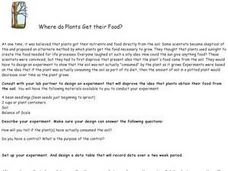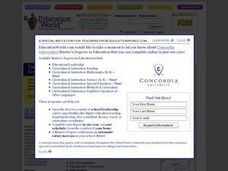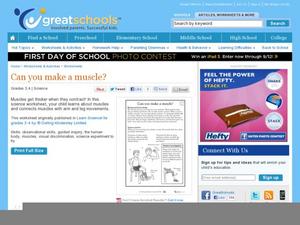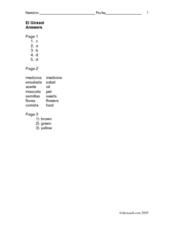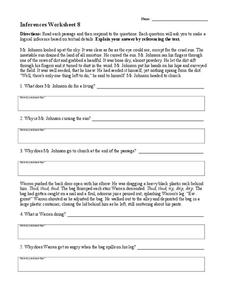Cold Spring Harbor Laboratory
Genes Don't Blend
Yellow and blue make green—unless you're studying the inheritance of genetic traits. An interactive lesson explains the difference between blended traits and pure traits and gives examples of their occurrence. The resource includes a...
Curated OER
Fantastic Flower
Here is a clever activity on pollination of flowers for you. In it, learners study the anatomy of a flower, and play a game in which they simulate the process of pollination. This fine plan brings in elements of art, physical education,...
Curated OER
Lifestyles of the Eco-Friendly
A helpful activity encourages pupils to make environmentally-friendly choices at home. The packet presents many ways that learners can help the environment, such as taking shorter showers in order to conserve water.
Curated OER
Modernizing a Traditional Irish Folktale
Learners write their own folktales based on "Cathal O'Cruachan and the Cowherd." In discussions they examine the animal symbolism in the story, as well as the characters, events, problems, and solution. With partners, they select...
Curated OER
Where Do Plants Get Their Food?
Plants need food to survive, just like any other living organism. Young biologists analyze an experiment performed in 1610 by Jan van Helmont to determine if plant nutrition is obtained through the soil. First, lab groups work together...
Curated OER
Holes
In this reading worksheet, students answer 10 multiple-choice questions about the book. For example, "Why was Stanley sent to Camp Green Lake?"
Curated OER
Parts of a Plant
First graders discover the parts of a plant. For this science lesson, 1st graders identify and label the parts of a plant and record their findings on a word processor.
Curated OER
Nuts for Peanuts: Peanut Plants, Peanut Timeline, and Peanut-s-timation!
Students complete a timeline. In this peanuts lesson, students read A Short Peanut History and use this resource to make a timeline of the history of the peanut. Students can grow peanuts in the classroom or make various peanut recipes.
Curated OER
Pea Plant Punnett Square Worksheet
How often do you find a science activity that comes with separate teacher's instructions? Here is one of those rare instances. Goals and objectives, materials, and evaluation guidelines precede the actual assignment. Biology leaners...
Curated OER
Fall 2003 Midterm Exam #3
Let there be light! When your physics learners take this midterm exam, light will be their focus. They will show what they know about electromagnetic waves, interference, refraction, reflection, lenses, prisms, and more! The test is...
Curated OER
Pollination Power
Second graders study and examine the structure of a flower. In this pollination lesson, 2nd graders observe pollinators in the garden and dissect a flower. Students then plant strawberry plants in the garden and observe the process...
Curated OER
Introduction to Plants
A vast overview of avascular and vascular plants, this PowerPoint displays all of the notes your botanists need to take. It lists primitive plant groups and their characteristics. It separates gymnosperms and angiosperms, also detailing...
Curated OER
Forest Ecosystems
Forests are briefly defined and broken down into four different types in this PowerPoint. Facts and photos are provided for each type, including: deciduous, tropical rain, coastal, and coniferous forests. This is a wonderful presentation...
Primary Resources
Science - The Parts of a Flower
Here is what a PowerPoint presentation should look like! This excellent show lets students know what they will be learning about, takes them through nicely-designed examples, leaves room for discussion questions, has a built-in activity,...
Curated OER
The ee Sound
When two vowels take a walk, the first one does the talking! Scholars see this motto put to use as they study the /ee/ sound in various spelling patterns. Learners read a short introduction on this concept before reading several example...
Curated OER
Editing
Take young authors through the writing process with a worksheet on editing. Given three sentences with unnecessary words, pupils cross out the extra words and write the rest of the sentence in the space provided. An excellent way to...
Curated OER
Can You Make a Muscle?
Why are muscles important? Third graders study the different kinds and functions of muscles in the human body. After drawing arrows in an illustration to indicate where a muscle contraction would occur, they do their own experiment about...
Curated OER
Good Drugs, Bad Drugs
Add a science experiment on medicine and drugs to your health lesson. After reading a paragraph on the difference between helpful and harmful drugs, kids choose which pictures of bottles they could find at a pharmacy. The last activity...
Curated OER
El Girasol
Learn a bit about sunflowers through a short reading passage. Then, read the five reading comprehension questions that follow. On the second page, match the Spanish word to its English translation. On the final page, have your learners...
Curated OER
The Pumpkin: An Outstanding Teaching Tool
Capitalize on the availability of this seasonal squash by designing a lesson for a variety of disciplines.
Curated OER
Investigating the Effect of Minerals on Plant Growth
How do different minerals affect the growth of plants? Budding botanists find out in a multi-week experiment that has them using solutions with specific mineral deficiencies. While there is a lot of preparation for the investigation,...
Reading Worksheets
Inferences Worksheet 8
Lead your class toward mastery of making inferences with a straightforward worksheet. Pupils read four short passages and make inferences based on the questions asked about each passage. They explain their reasoning for each...
It's About Time
Photosynthesis, Respiration, and the Carbon Cycle
Provide your class with the opportunity to view our carbon cycle close up. Young scientists research the cycle of oxygen as it completes the tasks of photosynthesis and respiration. They explore the importance of carbon in an ecosystem...
Maryland Department of Education
The Concept of Diversity in World Literature Lesson 7: Cultural Commentary
As part of their study of Things Fall Apart, class groups develop a multimedia presentation in response to the question, "In what ways does Achebe use literature as a means to express and comment on culture and history?"
Other popular searches
- Plants and Seeds
- Growing Bean Seeds
- Planting Seeds Sequencing
- How Seeds Travel
- Planting Seeds
- Bean Seeds
- Fruit Seeds
- Growing Seeds
- Growing Plants From Seeds
- Apple Seeds
- Hitchhiker Seeds
- Corn Seeds






